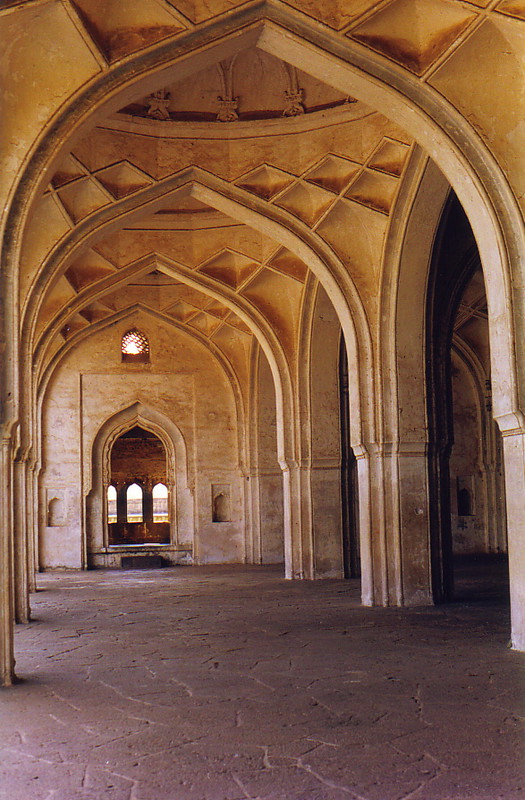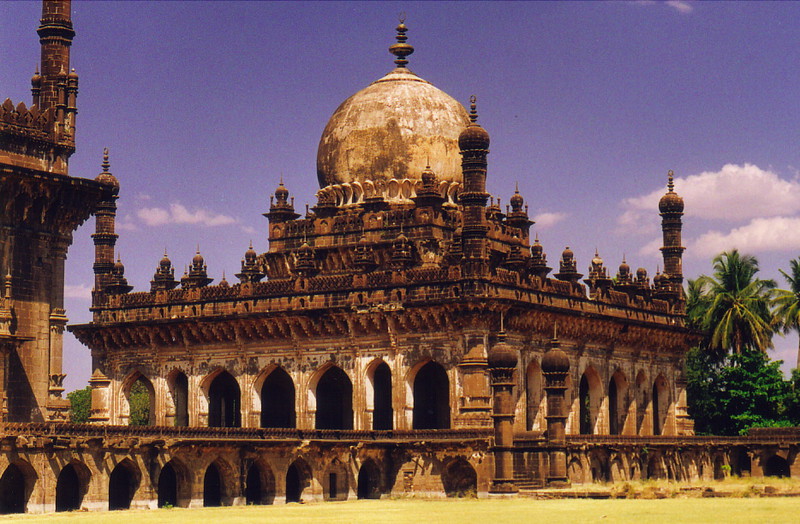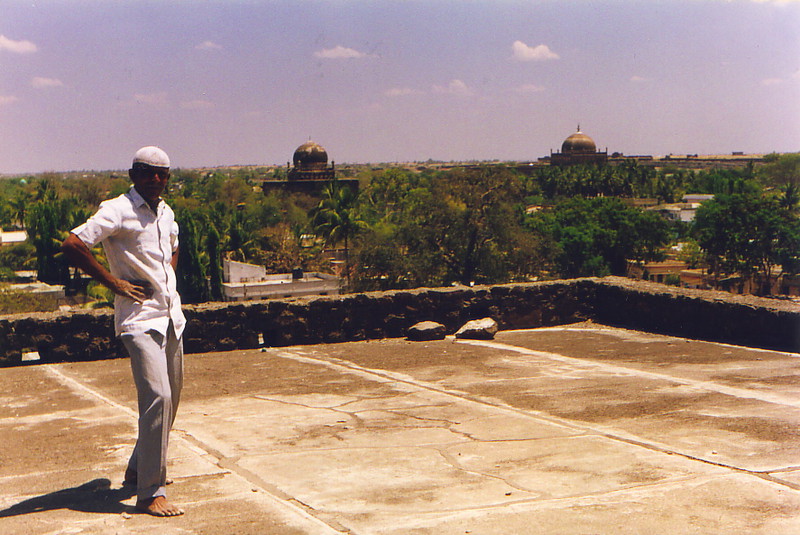
Waving goodbye to my Hampi friends as they boarded the bus for the southbound train, I felt a strange yet familiar feeling. Yes, it was sad to be seeing newly discovered kin disappear into the evening sun, but I suddenly felt that little thrill associated with being alone again, with being independent and having to make my own decisions.
Those decisions included leaving Hampi the next day and jumping on the train to Bijapur, a major town to the north. It struck me on arrival that Bijapur feels quite a lot like Hyderabad, and a glance at the map shows that the distance between the two isn't that great; indeed, Bijapur has a large Muslim population just like Hyderabad, which probably explains it.
Bijapur's great attractions are architectural, specifically its Islamic architecture. Minarets, domes and echoing burial chambers all conjure up images of the Arabian Nights, with crescent moons rising in clear starry skies while camel trains stand silhouetted on the desert horizon; even the wailing of the muezzin stirs me in a strange way, even if it's just in frustration at being woken up at 4am yet again. Whatever the western image of Islam, its atmospheric grace never ceases to amaze me.
The Golcumbaz

The Golcumbaz, for example, is astounding. A huge domed building, looking slightly ungainly but definitely impressive, the Golcumbaz's appeal lies not so much in its impressive size and structure, but in the aural effect of its dome. The dome contains a whispering gallery, and it's a stunner.
Climb up to the balcony inside the dome and clap your hands, and the sound gets echoed back to you ten times in an explosion of noise that borders on the spooky. Make a raspberry sound and listen to a choir of flatulence; blow a whistle and marvel at sounds that even Roger Whittaker couldn't reproduce; sneeze and the whole world sneezes with you. But listen in silence and the true power of the Golcumbaz becomes apparent.
That is, it becomes apparent if you can manage to find silence in which to listen; after all this is India, where silence in public places is a rarity, especially given the sheer number of people in the country. But against all the odds I managed to coincide my visit to the Golcumbaz with the only time of the day when the hordes of Indian tourists were in transit between sights, and I had the whispering gallery to myself for a good five minutes. It was during this time that I discovered the true secret of the dome.

Dotted around the perimeter of the dome are eight little doorways onto the roof, each of them shaped in the traditional archway design of Islam, and through these doors waft the sounds of the city. Through one doorway the lilt of the market-wallahs selling their goods echoes tenfold on the roof; through another the rickshaw horns argue with each other in triple triplicate; yet another amplifies the warbling of the Muslim call to prayer; and over there a door catches a flock of birds as they chatter on the outside parapet, oblivious to the eavesdropper inside. The Golcumbaz is the Islamic equivalent of the mixing studio – or, to be more theistic, the Islamic equivalent of an all-seeing, all-hearing god – and for five minutes I was privileged enough to be in a studio free of Hindi pop artistes.
Of course, the silence didn't last, and just as I reached the end of my personal repertoire of funny noises, a troupe of Indians appeared through one of the doors and proceeded to scream, clap, screech and expectorate1 in a cacophony of sound that would have woken the ancient Islamic king buried in the cellar if he hadn't already given up trying to rest in peace. I retreated to the comparative peace of the city streets before my eardrums suffered permanent damage.
The Incomparable Ibrahim Roza

Other beautiful buildings followed, such as the simple yet striking Jama-e-Masjid Mosque; the Asar Mahal, where kids play cricket in the nearby water tank, and I was accosted by a crazy old man who kept shouting, 'Cumoncumon!' as he dragged me up to the roof and insisted I take pictures of him prancing around before demanding some baksheesh; and the Citadel, which sports some beautiful ruins and pleasant parks.
But little prepared me for the sheer beauty of the Ibrahim Roza. Scorched by sunlight and surrounded by parched parks, the minarets and domes of the twin burial tombs of this astoundingly beautiful building summarise everything that is aesthetically emotive about Islamic architecture. Perfect domes are topped with crescent moons, surrounded on four corners by symmetrical minarets that manage to combine structural simplicity with intricate stonework; doorways with the distinctive pointed arch lead into cool high-ceilinged chambers, sheltering the tombs from the outside world and cutting off almost all traces of city bustle; covered walkways around the perimeters of the buildings provide a contemplative environment for a relaxing read or (if you really want to be a local) a quick snooze; and all the time there's a background vibration of history, long marches, religious wars, scimitars, sultans and Persian love stories.

Even the small group of locals who invaded my peace did it in a respectable and almost welcome way, saying, 'Excuse me sir, sorry to disturb you,' before launching into a surprisingly elegant and worthwhile conversation. The concepts of Islam and modern India sometimes appear to be at loggerheads, the former being strict and regulated and the latter strictly unregulated, yet there are more Muslims in India than in most purely Muslim countries, including all of the Arab states; it also seems to be the case that Indian cities with large Muslim areas are generally more respectable and less chaotic than their Hindu counterparts. Many people would say that this is a shame, and would point to the busy insanity of India as one of its main attractions, but I beg to differ; the contrast of Islamic India with the Hindu mainstream is like a breath of fresh air that makes you appreciate both religions more. Furthermore, I just adore Islamic architecture, Islam's evocative histories and the (comparatively) reticent politeness of Muslims. I sometimes wonder if westerners have more in common with the Muslim Indians than Hindu Indians; this might seem a strange thing to say, given the traditional gulf between the West and Islam, but when you see the different religions in action, it certainly makes you think.
Holi in Bijapur

On the other hand, there were three areas where the austere nature of Islam seemed to crumble in Bijapur. First, some places celebrate Holi not only on the full moon, but also on a few specific days afterwards, and sometimes every day of the following week. 17 March was evidently one of those days in Bijapur, and I saw plenty of people wandering around smothered in purple and silver (the favourite colours of the Bijapurians, presumably); I even managed to gain a few facial and arm stains myself, much to the glee of the local populace. One assumes that only the Hindus actually participate in the Holi celebration, but the proliferation of brightly coloured people and the ubiquitous smell of alcohol clashed vibrantly with the traditional view of an Islamic town.
Second, Bijapur was full of pigs, more so than any other Indian city I've visited. Muslims don't eat pigs, but in a strange display of opposites attracting, Bijapur snorted and rummaged around in the dirt with the best of them.

But surely the biggest clash between cultures is when a foreigner like myself visits a peaceful Muslim tomb and ends up doing the Temple Tango. This dance, a common sight when white people explore temples in India, is a simple consequence of having to take off your shoes at the entrance to every temple, leaving you to enter on bare feet. This is fine in theory, but when the summer sun has been baking the stone slabs all day, it's a bit much to bear when your feet aren't hardened up like the local soles, and you end up hopping around from shadow to shadow, muttering ows and ouches in increasingly loud volume as the heat builds up on the balls of your feet. Of course, you have to leave your shoes outside Hindu temples as well as Muslim ones, but in a Hindu temple the Temple Tango isn't quite so noticeable among the busily fascinating activities that seem to take place all the time. In a Muslim tomb, though, it feels rather out of place; I just hope my hopping round the Ibrahim Roza didn't look as disrespectful as it felt.
1 This was despite the poetic nonsense of the sign downstairs proclaiming that 'Spitting and writting [sic] is strictly prohibited'. Chalk up another great sign in a country that excels in this lost art.